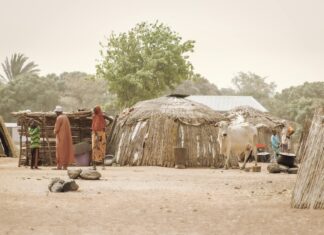By Chris Paul Otaigbe
As Nigeria clears her head from the ashes of its Covid-19 caused collapsed Oil wealth, she can do with anything that can generate some income including resources, which is an invasive plant by nature, but hitherto, cleared off as an aquatic waste.
Could this waste be the steroid that may stimulate a possible agro-economy for the country as she battles to balance dwindling revenue with a deepening budget deficit?
If what its horticultural research institute has discovered is anything to go by, one such waste that could become useful for Nigeria in the wake of the pandemic scourge on her economy, is the Water Hyacinth.
The National Horticultural Research Institute (NIHORT), Ibadan, in Oyo State, says it has explored the nutritional component of water hyacinth by utilizing its (water hyacinth) research for cultivation of mushroom.
The NIHORT Executive Director, Dr. Abayomi Olaniyan, made this known to the News Agency of Nigeria (NAN) on Friday in Ibadan.
Olaniyan said an efficient substrate ration, which gave high number of fruiting bodies and yield when compared with conventional substrate-saw dust, was obtained and applied in the cultivation of mushroom.
According to him, water hyacinth contains about 26 percent crude protein, 26 percent fibre, 17 percent ash and eight percent available carbohydrate on dry weight basis.
He added that its dried pressed cakes were comparable in fibre content to cotton seed hulls and sugarcane base.
Olaniyan emphasized that NIHORT had made several releases of weevils such as Neochetina eichhornia, (a biological control agent of water hyacinth) in all infested waterways of Lagos, Ogun, Ondo, Edo, Delta and Bayelsa.
Other states, he said were: Rivers, Akwa-Ibom, Cross River, Niger and Kebbi.
On its production techniques, Olaniyan said it made development of protocol for improved production of planting material for plantain/banana, pineapple and irvingia (ogbono) through biotechnology.
He said it produced improved planting materials of vegetable seeds of tomatoes, pepper, Okro, Amaranth, Celosia (Soko), Corchorus (Ewedu), among other crops for farmers, students and researchers.
“We have value-added products developed from tomatoes such as tomato dried slices, puree, powder, whole peeled tomato, and development of raised platform (sun dryer) for tomato fruits.
“We made reduction of post-harvest loses of horticultural crops through the development of different value-added products such as bottled fruit juice from citrus, mango, pineapple and utilization of plantain confectioneries.” He said.
He added that its horticultural packaged waste produced four different kinds of soaps, which include: herbal, natural, batch gel and liquid soaps, as well as production of bio char, biogas, compost and silage, made from horticultural waste.
“Organic fertilizer was produced from a mixture of horticultural wastes, horticultural waste shredding machine fabricated for animal feed, there is decorticator machine fabricated for bush mango, among other products developed,” he said.
Olaniyan said that the institute faced the challenge of insufficient, late release of funds to meet agricultural production season, as well as insufficient research project vehicles, adding that its challenges also included obsolete research equipment for quality research results, obsolete/insufficient irrigation facilities for production during off-season, among others.
Water hyacinth is a free-floating perennial aquatic plant (or hydrophyte) native to tropical and sub-tropical South America. With broad, thick, glossy, ovate leaves, water hyacinth may rise above the surface of the water as much as 1 meter (3 feet) in height. The leaves are 10–20 cm (4–8 inches) across on a stem, which is floating by means of buoyant bulb like nodules at its base, above the water surface. They have long, spongy and bulbous stalks. The feathery, freely hanging roots are purple-black. An erect stalk supports a single spike of 8–15 conspicuously attractive flowers, mostly lavender to pink in colour with six petals. When not in bloom, water hyacinth may be mistaken for frog bit (Limnobium spongia) or Amazon frog bit (Limnobium laevigatum).
When not controlled, water hyacinth will cover lakes and ponds entirely; this dramatically affects water flow and blocks sunlight from reaching native aquatic plants, which often die. The decay processes depletes dissolved oxygen in the water, often killing fish (or turtles). The plants also create a prime habitat for mosquitos, the classic vectors of disease, and a species of snail known to host a parasitic flatworm, which causes schistosomiasis (snail fever).
Directly blamed for starving subsistence farmers in Papua New Guinea, water hyacinth remains a major problem where effective control programs are not in place. Water hyacinth is often problematic in man-made ponds if uncontrolled, but can also provide a food source for goldfish, keep water clean and help to provide oxygen.
Water hyacinth often invades bodies of water that have already been affected by human activities. For example, the plants can unbalance natural lifecycles in artificial reservoirs or in eutrophied lakes that receive large amounts of nutrients.
In some other parts of the world, researches have been carried out to make water hyacinth into a profitable crop instead of a serious pest. In Bangladesh, the Mennonite Central Committee has been experimenting with paper production from water hyacinth for some years.
They have established two projects that make paper from water hyacinth stems. The water hyacinth fibre alone does not make a particularly good paper but when the fibre is blended with waste paper or jute, the result is reportedly good.
Similar small-scale cottage industry papermaking projects have been successful in a number of countries, including the Philippines, Indonesia, and India.
Another application of water hyacinth is the production of rope. The fibre from the stems of the water hyacinth plant can be used to make rope. The stalk from the plant is shredded lengthways to expose the fibres and then left to dry for several days. The rope making process is similar to that of jute rope. The finished rope is treated with chemicals to prevent it from rotting.
In Bangladesh, the rope is used by local furniture manufacturers who wind the rope around a cane frame to produce an elegant finished product.
In the Philippines, water hyacinth is dried and used to make baskets and matting for domestic use.
The key to a good product is to ensure that the stalks are properly dried before being used. If the stalks still contain moisture then this can cause the product to rot quite quickly. In India, water hyacinth is also used to produce similar goods for the tourist industry. Traditional basket making and weaving skills are used.
Charcoal briquetting is an idea, which has been proposed in Kenya to deal with the rapidly expanding carpets of water hyacinth which are evident on many parts of Lake Victoria. The proposal is to develop a suitable technology for the briquetting of charcoal dust from the pyrolysis of water hyacinth.
The project is still very much at the idea stage and both a technical and socio-economic study are planned to evaluate the prospects for such a project.
Water hyacinth can also be used to aid the process of water purification, either for drinking water or for liquid effluent from sewage systems. In a drinking water treatment plant, water hyacinths have been used as part of the pre-treatment purification step.
In sewage systems, the root structures of water hyacinth (and other aquatic plants) provide a suitable environment for aerobic bacteria to function. Aerobic bacteria feed on nutrients and produce inorganic compounds, which in turn, provide food for the plants.
Using the water hyacinth as animal fodder is a traditional practice in many areas of Asia, including China, Bangladesh, Indonesia, India, Malaysia, the Philippines, and Thailand. In Malaysia, fresh water hyacinth is cooked with rice bran and fishmeal, and mixed with copra meal as feed for pigs and ducks. However, it is suited to all animals as water hyacinth has high water and mineral content.
In China, it is common practice to mix water hyacinth in a pigswill containing a variety of other vegetable waste matter. The mix is boiled for hours until it is reduced to a mash. Coconut meal, fishmeal and groundnut cake plus corn and rice bran, are often added to the mash.
Five percent of water hyacinth in the total diet of pigs leads to significantly weight gains. However, feed containing 30 percent of more of hyacinth can reduce weight gain by over 90 percent. These tests show that water hyacinth as a feed for animals must be used with great care.
Water hyacinth is also a good feed for fish. For instance, the Chinese grass carp is a fast-growing fish, which eats aquatic plants. It grows at a tremendous rate and reaches sizes of up to 32 kilograms. It is an edible fish with a tasty white meat. It will eat submerged or floating plants and bank grasses.
The fish can be used for weed control and will eat up to 18-40 percent of its own body weight in a single day.
Other fish such as the tilapia, silver carp, and silver dollar fish are all aquatic and can be used to control aquatic weeds. Water hyacinth has also been used indirectly to feed fish.
Dehydrated water hyacinth has been added to the diet of channel catfish fingerlings to increase their growth. It has also been noted that decay of water hyacinth after chemical control, releases nutrients that promote the growth of phytoplankton with subsequent increases in fish yield.
Another agricultural use of water hyacinth is by turning them into green manure or as compost. As a green manure, it can be either ploughed into the ground or used as mulch. The plant is ideal for composting. After removing the plant from the water, it can be left to dry for a few days before being mixed with ash, soil and some animal manure.
In Sri Lanka, water hyacinth is mixed with organic municipal waste, ash and soil, composted and sold to local farmers and market gardeners. In Bangladesh, farmers have started producing fertilizer made from water hyacinth.
Another application of water hyacinth would be to use the dry mass for conversion into biomass-derived diesel by catalytic depolymerisation process.
With a yield of dry mass per hectare (200 tons), which is about seven times that of Napier grass (elephant grass, 30-35 tons), coupled with large amounts of sewage, the water hyacinth derivative can rise to over 600 tons.
If the harvesting and dewatering problems can be resolved, the plant could easily support large-scale diesel production. 200 tons of dry mass will provide the feedstock to produce about 65 tons of diesel, which means that 210 hectares would be sufficient to support the supply for a Model 2000 plant with a production capacity of 16 million litres of diesel, representing a value of about €7.5 million.
NIHORT is the only Federal Government parastatal given the mandate to conduct research into the genetic, improvement, production technologies, processing, storage, utilization and marketing of fruits, vegetables, spices and ornamental plants of nutritional and economic importance.
The NIHORT discovery provides a most enlightening window for the Federal Government to direct some of its Agriculture-based intervention fund, so that the Agency can play a vibrant role to accelerate food sufficiency for the Nigerian people and the nation’s economy.
Properly managed, the NIHORT experiment could easily put the country among the comity of nations who are putting the ‘waste to wealth’ attributes of the Water hyacinth to good use for their people and their economies.










